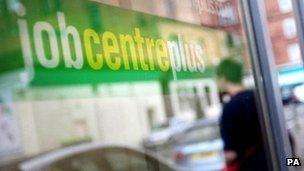More find jobs on Work Programme, DWP figures suggest
- Published

The Work Programme is meant to help the unemployed find lasting jobs
More people are finding jobs through the government's flagship back-to-work scheme, according to figures from the Department for Work and Pensions.
Some 13.4% of people referred to the scheme in the year to March found a lasting job - compared with 3.4% in the same period last year.
Ministers say the figures "demonstrate the growing success of the scheme".
But Labour said the scheme was still failing to meet the DWP's own targets and was "worse than doing nothing".
The programme is primarily aimed at getting people who have been unemployed for more than a year into a job.
It is delivered by 18 prime contractors working for the government and hundreds of smaller sub-contractors from the voluntary, community and private sectors.
Providers are paid by results, meaning they get most of the fee for finding someone a job that they stay in for up to two years. They get more for the harder-to-help jobseekers.
Dramatic improvements
Since it was launched in June 2011, 132,000 people have found lasting jobs on the scheme out of the one million referred to it, a success rate of approximately 13.4%.
Figures for the first year of the programme, which launched in June 2011, showed just 3.5% of the people referred to the programme got a lasting job.
The most dramatic improvements have been in the figures for people receiving jobseeker's allowance, with nearly a third of 18-24-year-old jobseekers finding work.
But only 5.5% of the unemployed people who have been moved to the programme from the Employment and Support Allowance, which supports sick and disabled jobseekers, found work.
The DWP said the new figures only counted those who have been in work for long periods - six months in most cases, or three months for the hardest to help.
Employment Minister Mark Hoban said: "The Work Programme is helping large numbers of people escape the misery of long-term unemployment and get back into real jobs.
"The improvement in performance over the past year has been profound and the scheme is getting better and better."
'Change needed'
He added that the worst-performing providers would begin to lose market share from August.
Shadow work and pensions secretary Liam Byrne, for Labour, said: "Three years into the Parliament, and nearly nine out of 10 people on this flagship programme have been failed.
"Worst of all, the government missed every single one of its minimum targets, and in nearly half the country, the Work Programme is literally worse than doing nothing.
"No wonder the benefits bill is £21bn higher than planned, and no wonder the chancellor himself was forced to attack 'under-performing' back-to-work programmes.
"We can't go on like this. We desperately need a change of course starting with a compulsory jobs guarantee that would make sure everyone out of work long term would have to take a job after two years."
The TUC was also scathing about the DWP's claims.
General Secretary Frances O'Grady said: "Ministers should know better than to try and spin the Work Programme as a huge success.
"Nearly two years on only one in ten people has found proper work through the scheme - a number that drops to just three in every hundred for disabled people."
Dame Anne Begg, chairman of the work and pensions committee, which recently criticised the Work Programme in a report, said: "This statistical release does nothing to reduce the fear that the Work Programme is failing to reach harder to help jobseekers."
But the figures were welcomed by business lobby group the CBI, which said providers and the government had to continue to push for improvement.
Jim Bligh, the CBI's head of public-sector reform, said: "Performance in supporting the hardest to help jobseekers needs to improve, but these people have significant barriers to work which take time to address."
- Published19 June 2013
- Published21 May 2013
- Published21 March 2013
- Published3 February 2013
- Published27 November 2012